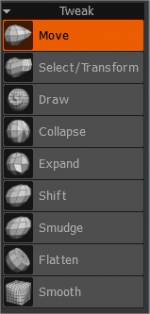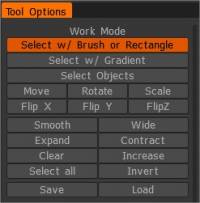
Μια άλλη περιγραφή όλων των εργαλείων είναι εδώ .
Χρησιμοποιήστε αυτά τα εργαλεία για να κάνετε μεγαλύτερες προσαρμογές πλέγματος αφού ολοκληρώσετε όλα τα άλλα βήματα μοντελοποίησης και υφής. Αυτή η λειτουργία έχει αρκετά εργαλεία για να μετακινήσετε το πλέγμα σας με μερικούς βασικούς παραμορφωτές.
Αυτό σας επιτρέπει να αναδιαμορφώσετε το πλέγμα σας, να αλλάξετε έναν λεπτό χαρακτήρα σε χοντρό και να δημιουργήσετε μορφοποιήσεις προσώπου για export. Αυτές είναι μερικές μόνο από τις χρήσεις αυτού του άμεσου πολυγωνικού συνόλου εργαλείων χειρισμού.
Μετακίνηση: Οι κινήσεις βασίζονται στο μέγεθος του Brush. Χρησιμοποιήστε αυτό το εργαλείο για να εκτελέσετε σημαντικές προσαρμογές στο πλέγμα σας. Πιέστε το CTRL για να σηκώσετε ή να χαμηλώσετε την επιφάνεια, περιορισμένη ώστε να παραμένει κάθετα στο πρόσωπο.
Προσπαθήστε να αποφύγετε το υπερβολικό τέντωμα μιας περιοχής πολυγώνων, ειδικά τη δημιουργία μακριών, λεπτών πολυγώνων (πατήστε “W” για να δείτε το συρμάτινο πλαίσιο), καθώς αυτό θα προκαλέσει ανεπιθύμητες παραμορφώσεις υφής στο μοντέλο “Baked” και θα απαιτήσει σημαντικές αλλαγές στον χάρτη UV σας.
Επιλογή/Μεταμόρφωση: Αυτό το εργαλείο σάς επιτρέπει να ορίσετε μια επιλεγμένη επιφάνεια επιλέγοντας το πλέγμα σας πριν εφαρμόσετε τη λειτουργία Μετακίνηση, Κλίμακα ή Περιστροφή σε αυτήν την περιοχή.
Υπάρχουν διάφορες εντολές στον πίνακα “Επιλογές εργαλείου” για να τροποποιήσετε την επιλεγμένη περιοχή, καθιστώντας αυτό το εργαλείο ένα πολύ ακριβές μέσο για την αλλαγή του πλέγματος σας, καθώς και τα μέσα για τις περιοχές επιλογής “Αποθήκευση” και “Φόρτωση”.

Οι διαθέσιμες παράμετροι για αυτό το εργαλείο είναι οι εξής:
- Επιλέξτε με πινέλο ή ορθογώνιο. Επιλέξτε με στυλό, ορθογώνιο ή καμπύλη. Χρησιμοποιήστε CTRL για να αφαιρέσετε την επιλογή και SHIFT – για να προσθέσετε επιλογή.
- Επιλέξτε με κλίση. Η επιλογή γίνεται με κλίση. Κάντε κλικ για να προσδιορίσετε τη θέση έναρξης στη διαβάθμιση και, στη συνέχεια, κάντε κλικ ξανά για να προσδιορίσετε το τελικό σημείο.
- Επιλέξτε αντικείμενα. Επιλέξτε ολόκληρο το αντικείμενο με LMB.
- Κίνηση. Μετακινεί την επιλεγμένη περιοχή.
- Γυρίζω. Περιστρέφει την επιλεγμένη περιοχή.
- Κλίμακα. Χρησιμοποιείται για την κλιμάκωση της επιλεγμένης περιοχής.
- Λείος. Ομαλή επιλογή.
- Επεκτείνουν. Επεκτείνετε την επιλογή.
- Σαφή. Εκκαθάριση όλων των επιλογών.
- Επιλογή όλων. Επιλογή όλων.
- Πλατύς. Διευρύνετε την ενδιάμεση περιοχή επιλογής.
- Σύμβαση. Συμβόλαιο για την επιλογή.
- Αυξάνουν. Αυξήστε την τιμή επιλογής κατά 10%.
- Αποθηκεύσετε. Αποθηκεύστε την επιλογή σε ένα αρχείο.
- Φορτώνω. Φόρτωση επιλογής από το αρχείο.
Σχεδίαση: Λειτουργεί όπως το εργαλείο Surface “Draw”, εκτός από το ότι τα πολύγωνα τεντώνονται για να γίνει η αλλαγή. Το μέγεθος, το βάθος και η φύση της Brush και το σχήμα Άλφα καθορίζουν τη δράση του εργαλείου.
Χρησιμοποιήστε τους τροποποιητές “Ctrl” και “Shift” για να εφαρμόσετε μια ενέργεια αντιστροφής ή εξομάλυνσης σε αυτό το εργαλείο.
Σύμπτυξη: Αυτό το εργαλείο προσεγγίζει τις περιοχές του πλέγματος πιο κοντά μεταξύ τους με πολύ ακριβή τρόπο χωρίς να ανυψώνει ή να χαμηλώνει την πληγείσα περιοχή. Το μέγεθος, το βάθος και η φύση του Brush Alpha επηρεάζουν την απόσταση της μετάφρασης του πλέγματος.
Χρησιμοποιήστε τον τροποποιητή “Ctrl” για να αντιστρέψετε τη δράση του εργαλείου – και τον τροποποιητή “Shift” για να χαλαρώσετε το πλέγμα.
Ανάπτυξη: Λειτουργεί ακριβώς ως ανεστραμμένη έκδοση του εργαλείου “Σύμπτυξη”.
Shift: Αυτό το εργαλείο ολισθαίνει και σπρώχνει ένα τμήμα του πλέγματος προς μία κατεύθυνση κατά μήκος του επιπέδου της υπάρχουσας επιφάνειας πλέγματος. Λειτουργεί σαν ένα δισδιάστατο «κύμα» του είδους. Χρησιμοποιήστε τον τροποποιητή “Ctrl” για να “απωθήσετε” το πλέγμα μακριά από τον δρομέα του Brush προς κάθε κατεύθυνση και χρησιμοποιήστε τον τροποποιητή “Shift” για να χαλαρώσετε τις περιοχές του πλέγματος.
Το εργαλείο επηρεάζεται από το μέγεθος και το βάθος της Brush , αλλά όχι από το σχήμα Alpha ή άλλες επιλογές Brush .
Μουτζούρα: Λειτουργεί παρόμοια με το εργαλείο Shift, αλλά τείνει να ανοίγει το πλέγμα κοντά στις άκρες του Brush.
Χρησιμοποιήστε τον τροποποιητή “Ctrl” για να αντιστρέψετε την ενέργεια και τον τροποποιητή “Shift” για να χαλαρώσετε τις περιοχές του πλέγματος.
Αυτό το εργαλείο επηρεάζεται μόνο από το μέγεθος και το βάθος της Brush.
Flatten: Λειτουργεί αρκετά παρόμοια με το εργαλείο “Flatten” στη λειτουργία Surface. Η ισοπέδωση της επιφάνειας κάτω από τη βούρτσα με επαναλαμβανόμενες κινήσεις της βούρτσας σε μια περιοχή τείνει να παράγει μια γενική ισοπέδωση, παρόμοια με το αποτέλεσμα που προκαλείται από το σφυρί του σιδηρουργού.
Ομαλή: Συνολικά, αυτό το εργαλείο εκτελεί μια χαλάρωση πλέγματος, μειώνοντας την απόσταση μεταξύ των γειτονικών κορυφών καθώς το εργαλείο περνά από πάνω τους.
 Ελληνικά
Ελληνικά  English
English Українська
Українська Español
Español Deutsch
Deutsch Français
Français 日本語
日本語 Русский
Русский 한국어
한국어 Polski
Polski 中文 (中国)
中文 (中国) Português
Português Italiano
Italiano Suomi
Suomi Svenska
Svenska 中文 (台灣)
中文 (台灣) Dansk
Dansk Slovenčina
Slovenčina Türkçe
Türkçe Nederlands
Nederlands Magyar
Magyar ไทย
ไทย हिन्दी
हिन्दी Tiếng Việt
Tiếng Việt Lietuviškai
Lietuviškai Latviešu valoda
Latviešu valoda Eesti
Eesti Čeština
Čeština Română
Română Norsk Bokmål
Norsk Bokmål